Ra Tarot
Modern interpretation of the Egyptian Tarot, as described by Ra.
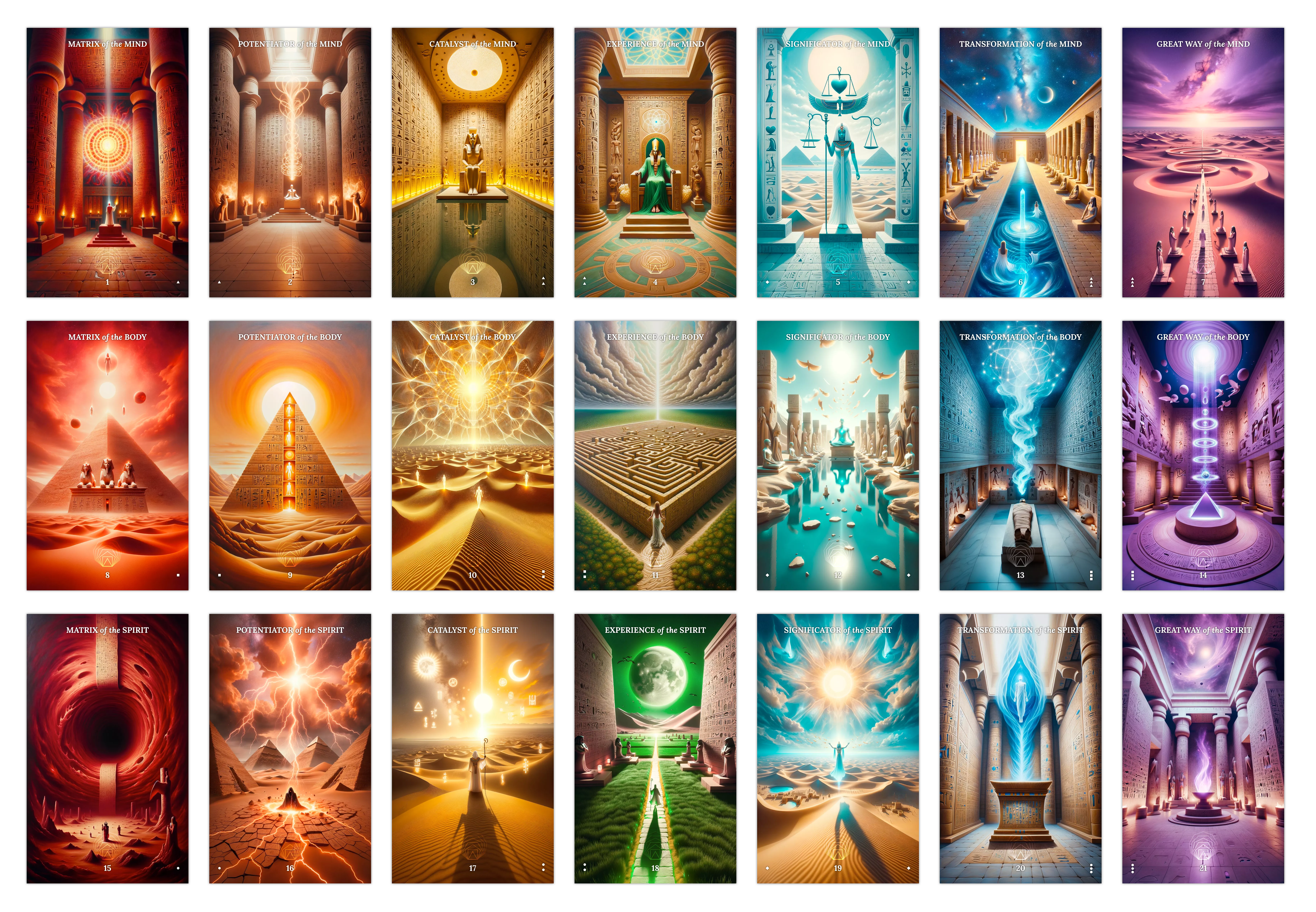
An attempt at translating the remarks of Ra, from the Law of One, with regards to the origin and original purpose of the Tarot. Interested readers should start with the source material and decide for themselves the relevance and credibility of this particular approach.
Ra offers a unique interpretation of the purpose of the Tarot – one which favors personal development – not divination. By focusing on the 22 Major Arcana, Ra recommends meditating on archetypes and their relative position in order to achieve personal development across mind, body and soul.
Ra states that the design of each card is of little importance, but I feel a contemporary visual representation might help the Ra Tarot reach a broader audience.
Therefore, it is not informative to reconstruct the rather minor differences in descriptive terms between the tarot used by us and that used by those of Egypt and the spiritual descendants of those first students of this system of study. [88.16]
My intent is to create and publish a modern interpretation of the Major Arcana, along with a guidebook and support cards to help adepts read the Ra Tarot. I don't expect this to be a solo journey, and hope to find creative collaborators along the way.
Reading Ra
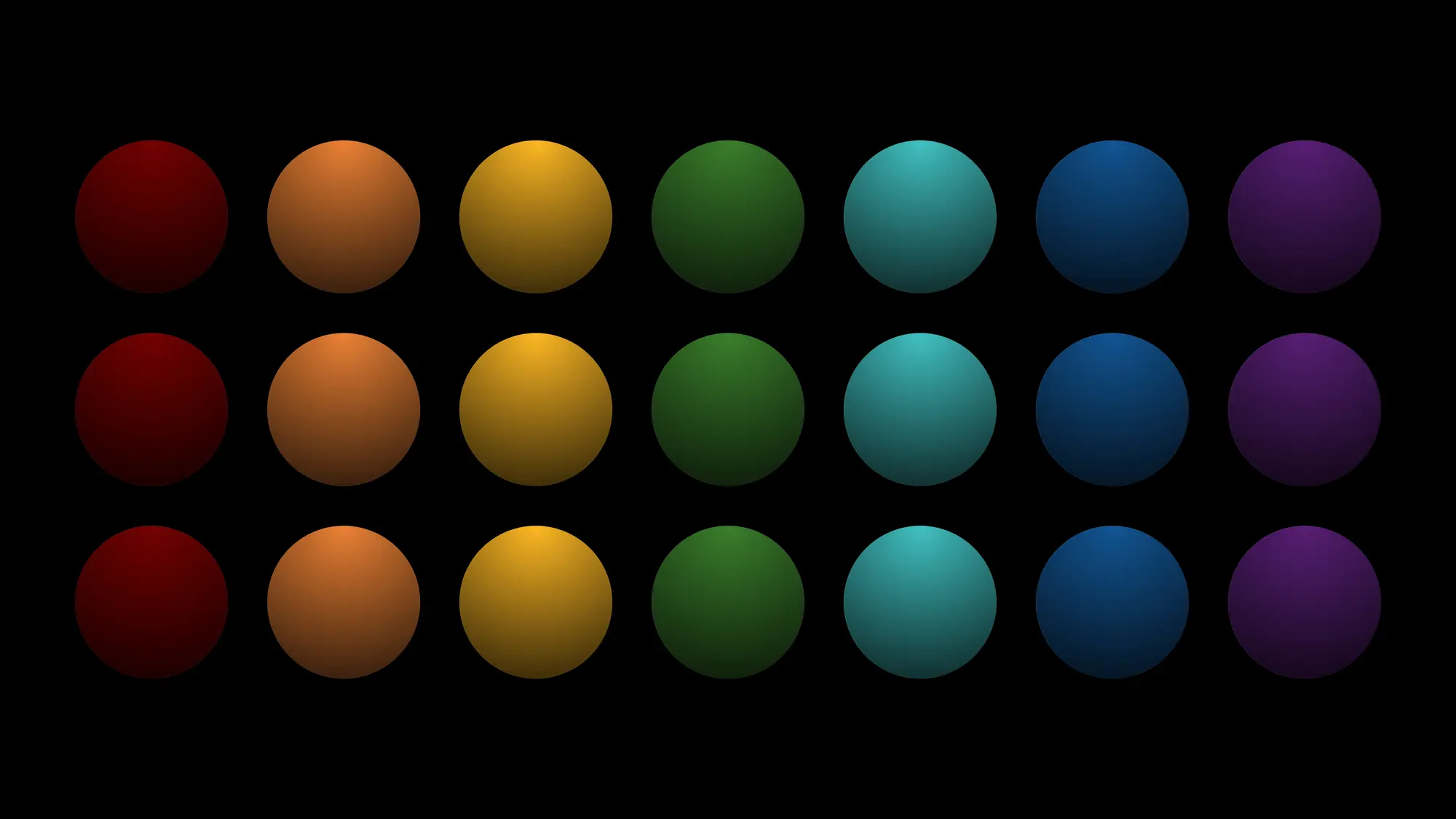
There are as many ways to read the Tarot as there are readers.
Some Tarot readers would consider a deck complete only with seventy-eight cards – 22 Major and 56 Minor Arcana. Ra Tarot is different from that view in that it focuses exclusively on the 22 Major Arcana.
Questioner: Were the Court Arcana and the Minor Arcana a portion of Ra's teachings or was this something that came along later?
Ra: I am Ra. Those cards of which you speak were the product of the influence of those of Chaldea and Sumer. [88.22]
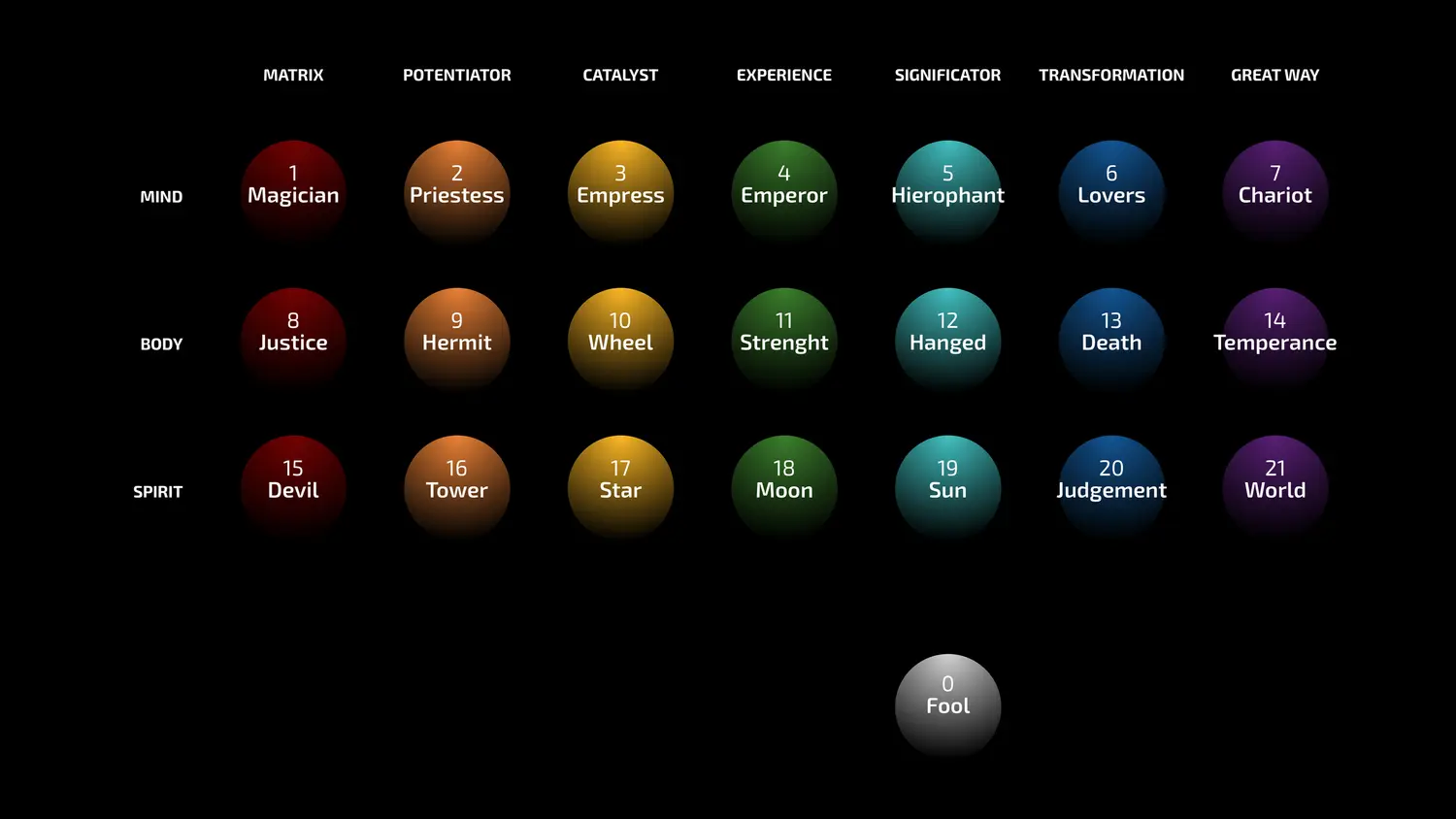
In Ra Tarot, the 22 Arcana are organized thusly:
- 1 Choice – or Fool card.
This card represents the Tarot adept (reader or querent, the person being read to) as an individual navigating the world. - 21 Archetypes
Each archetype corresponds to a situation, person or possibility in the mind/body/spririt of the reader as they experience reality. - 7 Octaves
Each octave, or correspondence, represents a transition or phase in the development of the adept. These shall be explored in further detail, but are called: Matrix, Potentiator, Catalyst, Experience, Significator, Transformation and Great Way. - 3 Foundations
Each foundation, or path, represents the aspect of the adept which is experiencing the Archetype. They are the Mind, Body and Spirit.
Interpreting Ra
In the Ra Material, Ra discusses the Tarot as a system of study designed to help individuals understand the nature of the mind, the body, and the spirit. According to Ra, the Tarot was originally intended as a tool for self-discovery and contemplation, rather than for divination.
Ra describes the Tarot as consisting of 22 images, corresponding to the 22 Major Arcana cards, which they call the "archetypical mind." The archetypical mind is said to be a fundamental structure shared by all beings in the universe. The Tarot images represent various aspects of the mind and are organized into three main groups:
- The mind cycle (Cards 1-7): This group of images corresponds to the processes and experiences within an individual's conscious mind. It includes the ways individuals perceive and interact with their reality.
- The body cycle (Cards 8-14): These images relate to the experiences of an individual's physical body and how they influence the mind. They represent the intersection of mind and body, and the role of the body in shaping an individual's consciousness.
- The spirit cycle (Cards 15-21): This group of images pertains to the spiritual aspects of an individual's existence, including their connection with the divine or the higher self. These images explore the journey of spiritual awakening and evolution.
In addition to these three groups, Ra also emphasizes the importance of the 22nd image, known as the "Choice" or "The Fool" in traditional Tarot decks. This image represents the catalyst that drives an individual to explore their mind, body, and spirit, ultimately leading to spiritual growth and self-discovery.
Ra suggests that studying and meditating on the Tarot images can help individuals gain a deeper understanding of their own archetypical mind, providing valuable insights into their personal growth and spiritual evolution.
It's important to remember that the Ra Material is a channeled work, and its perspective on the Tarot might not align with traditional interpretations. As with any spiritual material, it's crucial to use discernment and personal resonance when evaluating its relevance and applicability.
MIND These images relate to the experiences of an individual's physical body and how they influence the mind. They represent the intersection of mind and body, and the role of the body in shaping an individual's consciousness. | BODY This group of images corresponds to the processes and experiences within an individual's conscious mind. It includes the ways individuals perceive and interact with their reality. | SPIRIT This group of images pertains to the spiritual aspects of an individual's existence, including their connection with the divine or the higher self. These images explore the journey of spiritual awakening and evolution. | |
|---|---|---|---|
MATRIX These cards are considered to be the foundational cards representing the core aspects of each cycle. |  Matrix of the Mind Represents the conscious mind and its potential to create and shape the individual's reality. It symbolizes the inherent power of the conscious mind to focus intention and manifest experiences. |  Matrix of the Body Represents the physical body and its ability to experience the material world. Symbolizes the inherent vitality and strength of the physical form and the role it plays in shaping the individual's life experiences. |  Matrix of the Spirit Represents the higher self or the divine aspect of the individual. It symbolizes the spiritual essence that exists within each person, often obscured by the illusions and distractions of the material world. Invites individuals to transcend their perceived limitations and connect with their true spiritual nature. |
POTENTIATOR These cards are considered to represent the potential energy or catalysts that activate and enhance the core aspects of each cycle. |  Potentiator of the Mind Represents the subconscious mind or the unconscious aspect that influences the conscious mind. Symbolizes the hidden knowledge, intuition, and inspiration that can guide and enhance the individual's mental processes and experiences. |  Potentiator of the Body Represents the catalyst that activates and enlivens the physical body. Symbolizes the process of self-discovery and introspection that allows an individual to understand and utilize their physical form more effectively. |  Potentiator of the Spirit Represents the transformative energy that drives spiritual growth and evolution. Symbolizes the process of breaking down old structures, beliefs, and limitations to make way for the emergence of the true spiritual self. |
CATALYST These cards are considered to represent the experiences or events that trigger growth and transformation within the core aspects of each cycle. |  Catalyst of the Mind Represents the variety of experiences that stimulate the conscious mind and shape the individual's mental processes. Symbolizes the creative and nurturing forces that inspire the mind to grow and evolve. |  Catalyst of the Body Represents the physical experiences and challenges that activate and engage the body. Symbolizes the cycles of change, growth, and transformation that individuals encounter in their physical lives. |  Catalyst of the Spirit Represents the spiritual experiences and influences that inspire an individual's spiritual growth and awakening. Symbolizes the guiding light and higher aspirations that lead individuals towards their true spiritual nature. |
EXPERIENCE These cards are considered to represent the actualization or manifestation of the potential energies and catalysts within each cycle. |  Experience of the Mind Represents the process of integrating and balancing the conscious and subconscious aspects of the mind. Symbolizes the establishment of structure, order, and control in the mental realm, which allows the individual to effectively utilize their mental power and knowledge. |  Experience of the Body Represents the process of finding balance and harmony within the physical body and its experiences. Symbolizes the need for fairness, equilibrium, and self-care in maintaining physical health and well-being. |  Experience of the Spirit Represents the process of spiritual transformation and the journey towards self-realization. Symbolizes the exploration of the deeper aspects of the self, the unconscious, and the spiritual realm, leading to a greater understanding of one's true spiritual nature. |
SIGNIFICATOR These cards are considered to represent the essence or the most important aspects of each cycle. |  Significator of the Mind Represents the higher wisdom and knowledge within the individual's mind. It symbolizes the search for truth, understanding, and the desire to gain insights into the mysteries of life. Represents the mind's potential for spiritual awakening and the role of the mind in the evolution of consciousness. |  Significator of the Body Represents the physical body's ability to surrender and let go. It symbolizes the release of old patterns, habits, and attachments that may be holding the individual back in their physical experiences. Highlights the importance of flexibility, adaptability, and the willingness to change in the journey towards physical harmony and well-being. |  Significator of the Spirit Represents the true spiritual essence or the divine spark within each individual. It symbolizes the joy, vitality, and creative energy that the spirit brings to life. Serves as a reminder of the individual's inherent connection to the divine and their potential for spiritual growth and self-realization. |
TRANSFORMATION These cards are considered to represent the process of change, growth, and evolution within each cycle. |  Transformation of the Mind Represents the integration and balance of the conscious and subconscious aspects of the mind. Symbolizes the process of making choices, achieving mental harmony, and the union of opposites within the individual's mental realm. The Transformation of the Mind card highlights the importance of understanding and embracing the different aspects of the mind in order to achieve personal growth and spiritual evolution. |  Transformation of the Body Represents the process of transformation and renewal within the physical body. Symbolizes the shedding of old patterns, habits, and attachments, allowing for the emergence of a new, healthier, and more balanced physical state. The Transformation of the Body card emphasizes the necessity of change, adaptability, and the willingness to let go of what no longer serves the individual's well-being. |  Transformation of the Spirit Represents the process of spiritual awakening and the realization of the true spiritual nature within each individual. Symbolizes the rebirth of the spirit, the process of self-evaluation, and the ultimate awakening to one's divine purpose. The Transformation of the Spirit card serves as a reminder of the individual's potential for spiritual growth and the importance of embracing their true spiritual essence. |
GREAT WAY These cards are considered to represent the culmination or completion of each cycle and the integration of the lessons learned. |  Great Way of the Mind Represents the mastery and control of the mental realm. It symbolizes the successful integration of the conscious and subconscious aspects of the mind, leading to a balanced and harmonious mental state. Highlights the importance of discipline, focus, and determination in achieving personal growth and spiritual evolution. |  Great Way of the Body Represents the achievement of balance, harmony, and equilibrium within the physical body. Symbolizes the successful integration of the physical and spiritual aspects of the individual, leading to a state of overall health and well-being. The Great Way of the Body card emphasizes the importance of moderation, balance, and the need for self-care in maintaining a healthy and vibrant physical existence. |  Great Way of the Spirit Represents the completion of the spiritual journey and the realization of one's true spiritual nature. Symbolizes the integration of all the spiritual lessons and experiences encountered throughout the individual's life, leading to a state of wholeness, fulfillment, and enlightenment. The Great Way of the Spirit card serves as a reminder of the ultimate goal of spiritual growth and self-realization. |
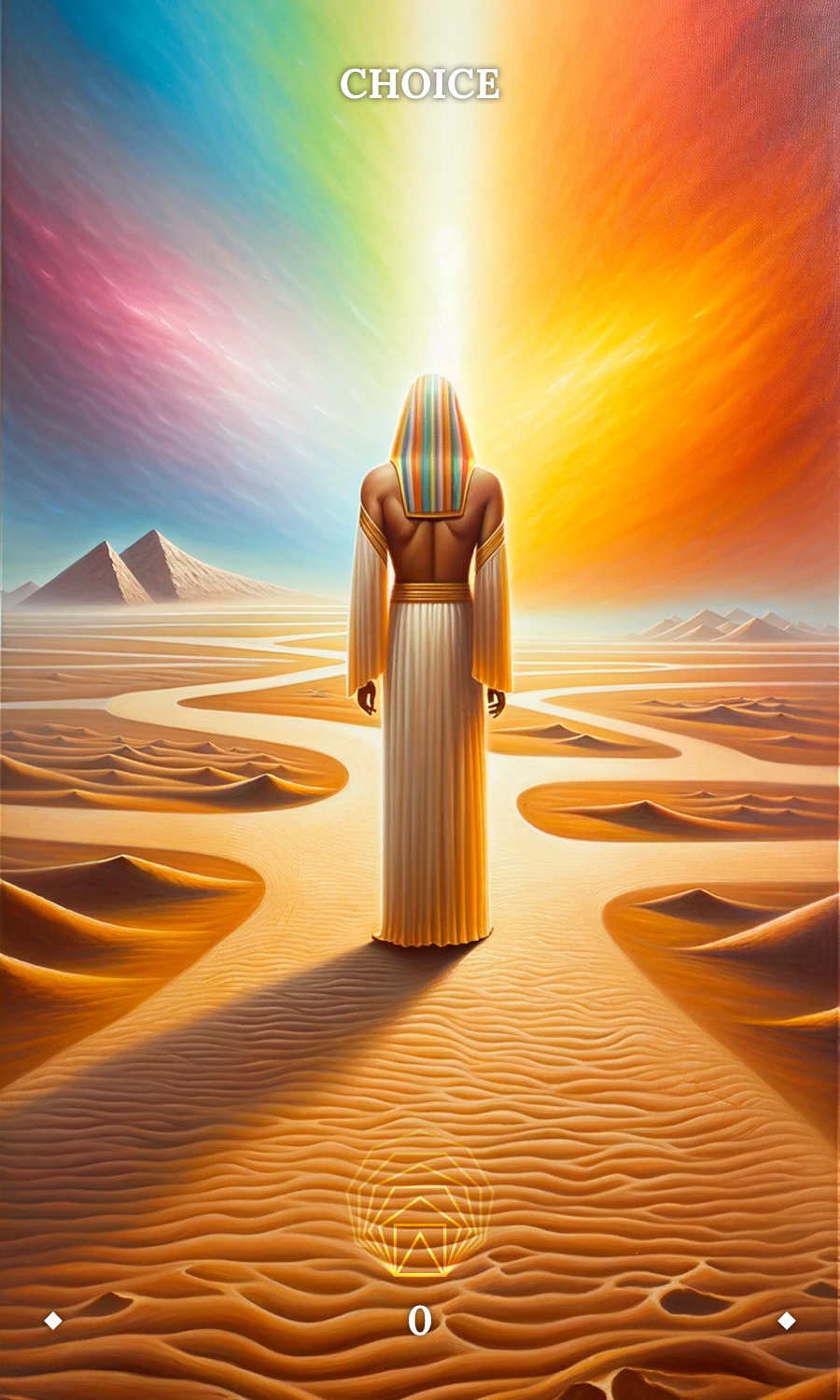 Choice Choice is an essential aspect of spiritual growth, as it allows individuals to exercise their free will and make decisions that align with their higher purpose. Throughout the Tarot, various cards symbolize the need for choice and the role it plays in shaping one's destiny. In the Ra Material, the idea of choice and free will is an important theme. They emphasize that each individual has the power to make choices that affect their spiritual growth and life path. By making conscious choices that align with their higher purpose, individuals can progress along their spiritual journey and ultimately achieve self-realization and enlightenment. | |||
Ra Numbering
Traditional Tarot organizes the Major Arcana according to the hero's journey, starting at the Magician, followed by the Priestess, the Empress, and so on.
Ra recommends reading the cards differently. Instead of looking at the Majors as three sets of seven, Ra recommends seven sets of three:
Ra: We find it more nearly appropriate to discuss our plans in acquainting initiates upon your own planet with this particular version of the archetypes of the archetypical mind. Our first stage was the presentation of the images, one after the other, in the following order: one, eight, fifteen; two, nine, sixteen; three, ten, seventeen; four, eleven, eighteen; five, twelve, nineteen; six, thirteen, twenty; seven, fourteen, twenty-one; twenty-two. In this way the fundamental relationships between mind, body, and spirit could begin to be discovered, for as one sees, for instance, the Matrix of the Mind in comparison to the Matrices of Body and Spirit one may draw certain tentative conclusions. [88.24]
Both approaches begin (1) and end (21) with the same cards, Magician and Universe. They also intersect in the middle (11) with Strenght.
I'm thinking of using both numbering schemes in future card design, helping adepts navigate the archetypes whichever way they see fit:
- Reading the arcana in three groups of seven (traditional) helps you understand the adept's journey, one world at the time.
- Reading them in seven groups of three (proposed) helps you internalize the octaves more clearly, and start understanding each of the seven octaves as a mind/body/spirit complex.
Research

I have been interested in the Ra Tarot since learning about it reading the The Law of One in 2014. Having no previous knowledge with reading Tarot at the time, I first set out to learn traditional interpretations and decks, which has been an immensely pleasant journey. Diverging from the traditional Tarot and interpreting it as instructed by Ra takes a bit getting used to, but should be straightforward to serious adepts.

Over the years I have used everything from pen & paper to computer-based approaches for making sense of the instructed framework and organizing my notes. Since deciding to publish a printed deck of cards, I figured it would make sense to share some of the process with fellow adepts. Below you will find some images and annotations of my process.
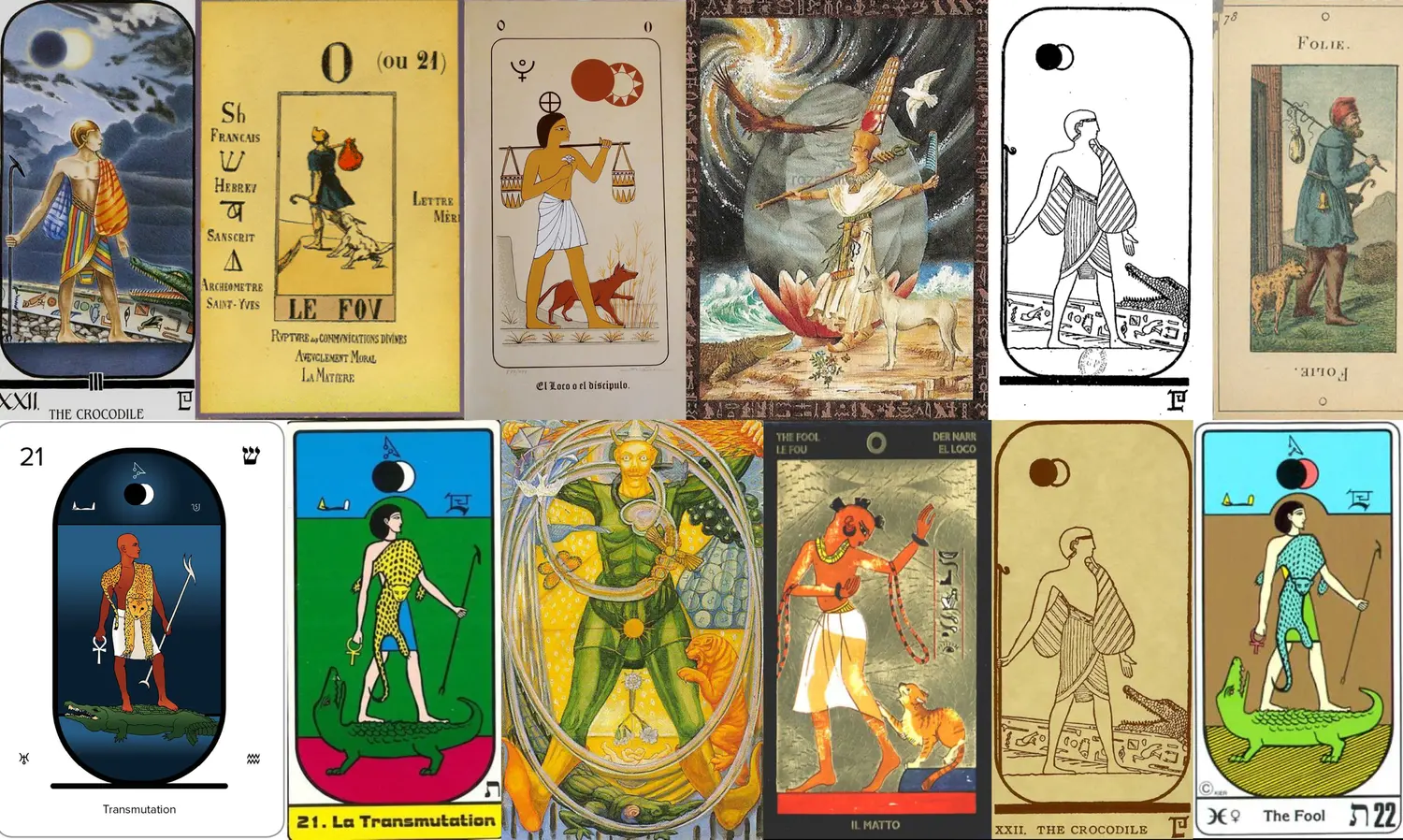
Collage of 'Fool' cards from various Egyptian Tarot decks.
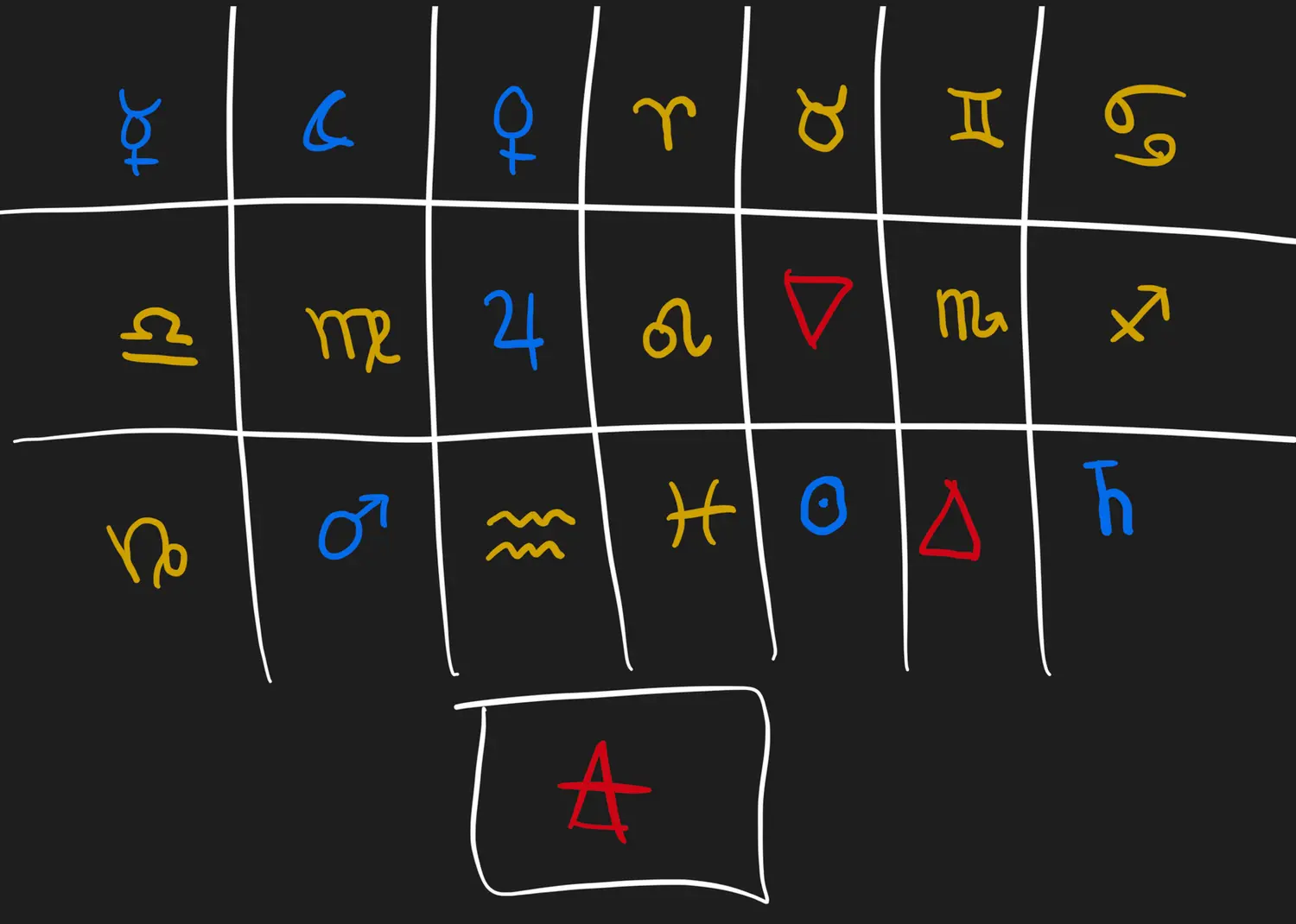
Hand-written snapshot from iPad Notes, showing correspondences between the arcana and astrological signs (blue = planets, yellow = signs, red = elements)
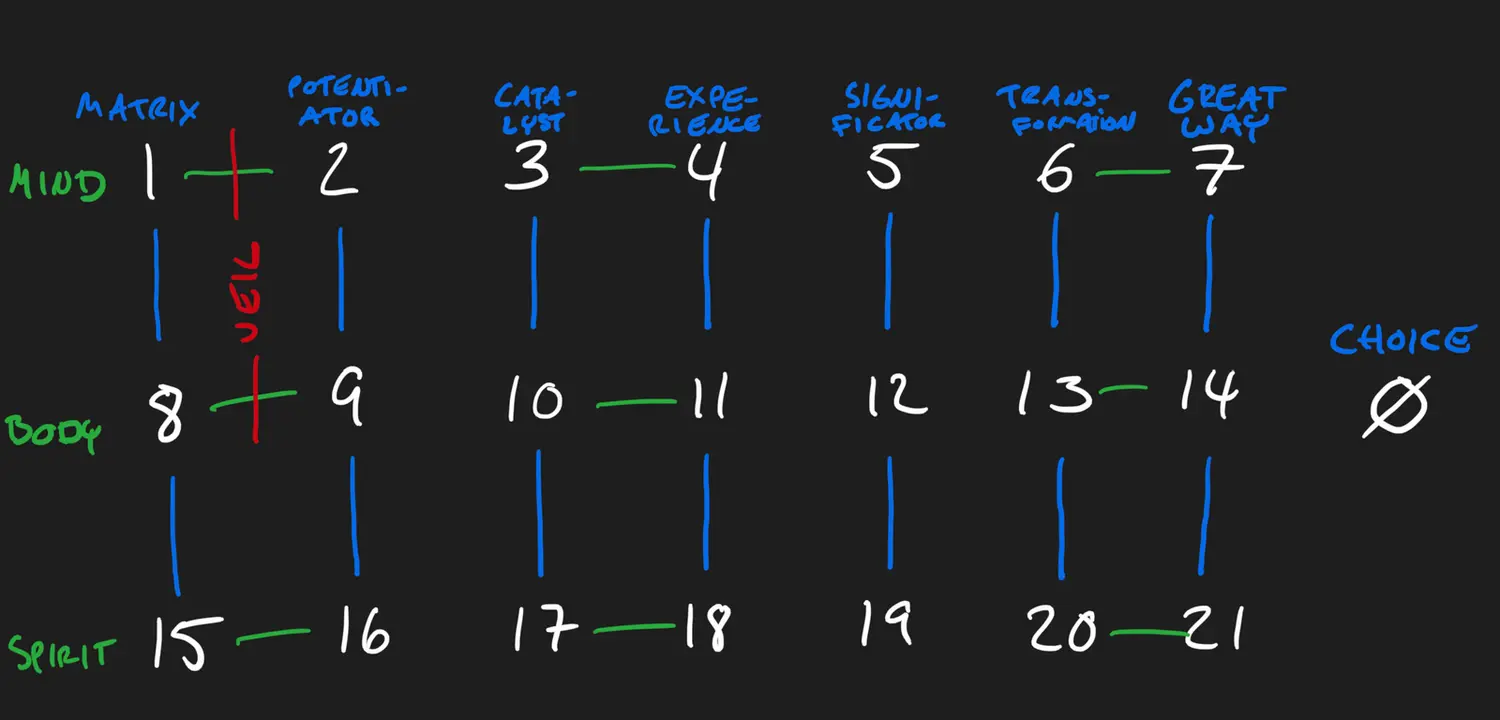
Hand-written overview of pairings between arcana.

Screenshot from Notion, a multi-purpose database tool for organizing linked data sets. 3 Paths = 3 Foundations.

7 Correspondences = 7 Octaves = 7 Chakras
Egyptian Decks

Screenshot from Muse where I'm organizing images, texts and handwritten notes on iPad + Mac, including various Egyptian Tarot designs.
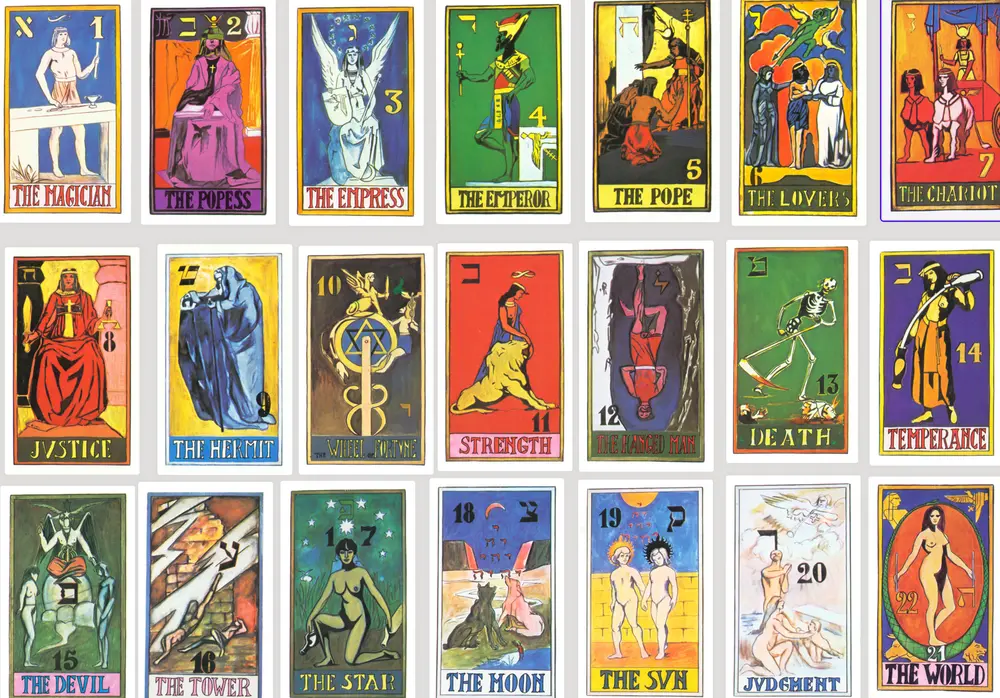
Papus (1909)

Apologia Del Thoth (1980)
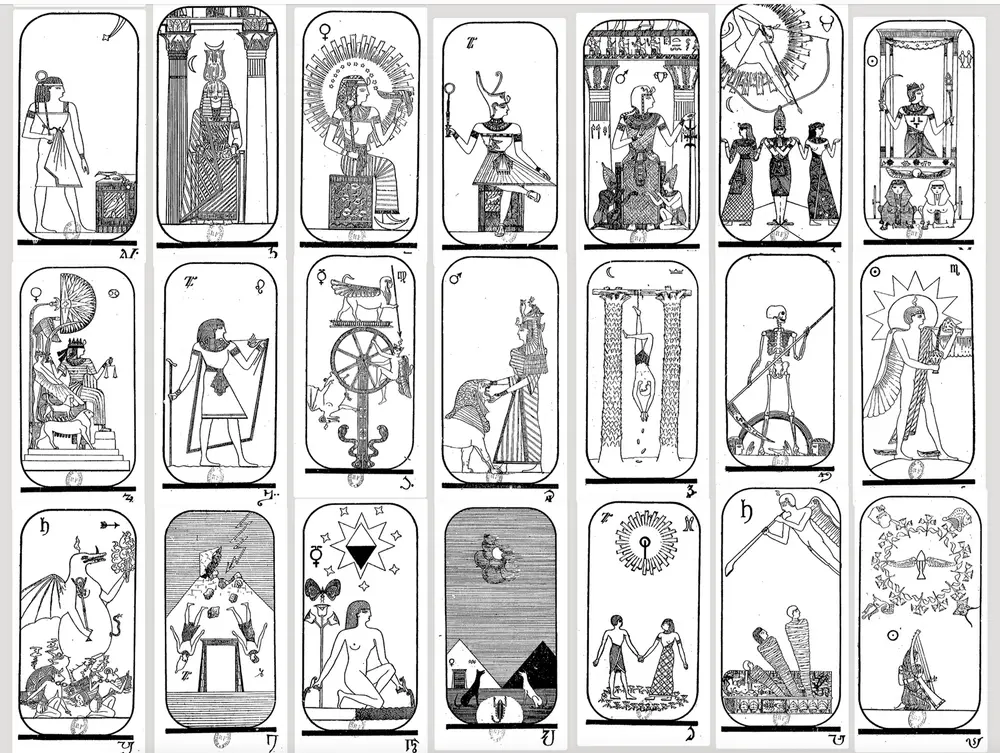
Falconnier (1896)

Tarot of the Bohemians

Assorted mentions of triads, heptads and twenty-twos from literature.
Resources
Learn more about the Law of One and how to interpret the Tarot according to Ra.
Websites
- LawOfOne.info > Category > Tarot
- Bring4th.org > Forum > Archetypes of Mind, Body & Spirit
- Reddit > r/lawofone – Especially this post.
- YouTube > Balraj Gill
- YouTube > Aaron Abke
- YouTube > Brian Scott
- YouTube > LawOfOneStudy
- Android-only: Archetypist for Law of One
- ODX > Law of One
Books:
- Tarot of the Bohemians – Papus
- The History and Practice of Magic – Paul Christian
- The Egyptian Mysteries - Iamblichus
- The Book of Thoth – A. Crowley
- Understanding Aleister Crowley's Thoth Tarot – LM DuQuette
- The Sacred Tarot – CC Zain
- Tarot Divinatoire – R. Falconnier
- The Royal Road – S. Hoeller
- History of the Occult Tarot – R. Decker & M. Dummett
- The Law Of One Tarot Workbook – B. Gill